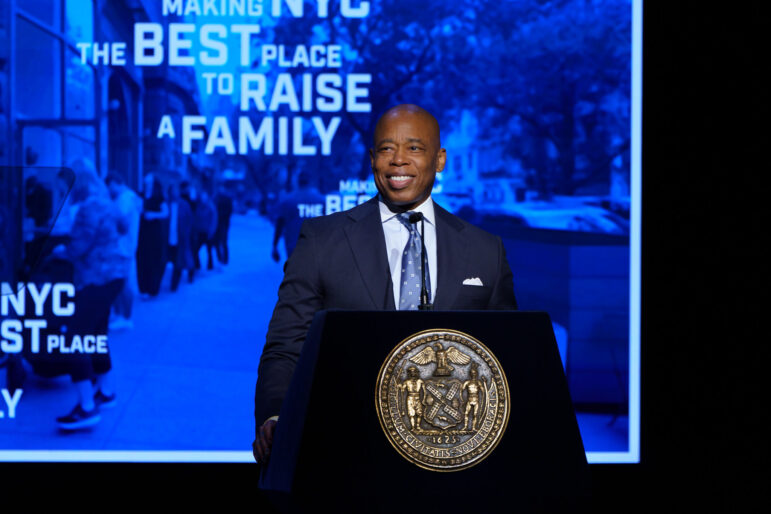You will surely remember the plot. It’s a Wonderful Life pits the “broken down ol’ Bailey Building and Loan” against the massive, callous bank run by Mr. Potter. The Baileys cared about common people and helped them build homes. The greedy Mr. Potter, lusting after money, tried to destroy them. It was a compelling match-up of little guy versus fat cat. But if the movie were made today, a very large out-of-state bank would be squeezing both the Building and Loan and Mr. Potter’s bank to sell out.
“There’ll come a time when people will see It’s a Wonderful Life and actually begin to see Potter as a good banker, because he actually had an interest in the community,” predicts John Taylor, head of the National Community Reinvestment Coalition, an advocacy group that presses for increased lending in poor neighborhoods. At least Potter had an office on Main Street, and he and his tellers lived in town They knew their customers. They had a stake in the place where they did business.
These days, many banks don’t. An unprecedented wave of mergers is reshaping banking, as former corporate rivals join together in multi-billion dollar deals designed to give them more market power and more cash to keep growing. Four of the 10 largest mergers in U.S. history happened between banks in 1998, and the top eight banks now control 35 percent of the nation’s deposited assets. The Federal Reserve estimates that another 2,000 to 3,000 banks could vanish in the next decade.
That consolidation craze is playing out just as traditional banking is becoming increasingly obsolete, and banks look to merge not just with other banks but also with insurance companies and investment firms. This fall, Congress passed a “financial modernization” bill that allows those marriages to happen. In the not so distant future, one corporation could operate the ATM you get cash from, insure the car you drive, handle the investments that you’ll live off during retirement, and pay out your life insurance benefit when you die.
Before Congress could approve the deregulation that banks have lusted after for two decades, Senate Banking Chair Phil Gramm made a hostage of the law that inner cities have come to rely on to guarantee access to banking (see Gramm’s Fairy Tales, City Limits, November 1999). Until the Community Reinvestment Act of 1977, banks were free to ignore poor areas, locking them out of mortgage and business lending. CRA changed all that by requiring every bank to meet the credit needs of the entire community from which it took deposits or else find themselves blocked from mergers and other major business deals.
Gramm’s crusade to crush CRA grabbed all the headlines, only to collapse at the last minute. Meanwhile, Congress was quietly ensuring that CRA would have no part in the new landscape of banking. With the new law, banks could expand into finance and insurance–but Congress refused to expand CRA along with the banks. Banks still have to maintain a decent rating with regulators if they want to merge, but the law won’t apply to the assets in those new subsidiary businesses. With banks free to lure big deposits to any part of their operations, the amount of cash earmarked for community lending is bound to plummet.
Until now, the mergers have meant boom times for CRA. Just recently, Citigroup pledged $115 billion in community lending; Fleet, $14.6 billion. Not coincidentally, these banks were both looking to close on unprecedented mergers with financial giants–Citibank with Travelers Insurance, Fleet with Bank Boston. Banks jockeying to merge are making sure to shore up their community lending to impress regulators. While CRA is credited with leveraging one trillion dollars to date, pledges in just the last few years have totalled in the hundreds of billions.
Community lending experts are dreading the bust they say will inevitably follow. But while the prospect of a dip in community lending is terrible news for neighborhoods, it isn’t entirely new. The banking business has already been leaving neighborhoods behind. Since CRA was passed two decades ago, massive amounts of cash have shifted from savings accounts to services like mutual funds and pensions–and cash covered by the law has correspondingly dwindled.
Now, as the shrinking number of banks exercise their new freedom to expand into these other services, the funding pipeline that neighborhoods depend on for developing housing, retail and community services is in serious danger of drying up. “What has coincided with branch closings and the mergers has been a strong economy and a strong CRA commitment by some banks, masking some of the problems,” says Taylor. “What will be left when the economy cools off is frightful. There may be just a shell of a banking system.”
Groups dependent on CRA money share that dread. “The kind of difference that CRA investment has made in our community is tremendous,” says Liz Blaney, head of the Jamaica office of the community development network Neighborhood Housing Services. “What we fear as a result of any changes is that there will be fewer dollars and less accountability for banks in our community.”
So while merger mania is hailed on Wall Street, it’s being watched warily in some city neighborhoods. Bigger banks are doing less home mortgage lending. Consumer fees keep rising at banks that have fewer competitors; a bounced check will now set you back $29 at Chase. And when out-of-state or foreign banks buy local institutions, the bonds between banks and communities are stretched thin–banks without a local base tend to know a territory based on its assets, not its specific needs.
These monumental changes in banking aren’t just making a certain movie obsolete. Communities and the organizations that work to keep them vital are being forced to rethink how they get what they need from banks–it’s either that, or risk going the way of the savings passbook.
_______
Poor neighborhoods have never had an easy time with the finance industry. In the 1930s the Federal Housing Administration urged underwriters not to give loans to blacks and Hispanics who wanted to move into white neighborhoods. At the same time, FHA itself refused to lend in minority neighborhoods.
The National Association of Realtors gave similar advice in the 1960s. “It was very difficult to get financing on small businesses or mortgages,” remembers Fran Justa, president of Neighborhood Housing Services. Redlining was often built into the rules–in the 1970s, Justa recalls, banks’ underwriting guidelines rejected houses with claw-foot bathtubs or those within so many feet of a commercial strip, stipulations designed to exclude old, urban neighborhoods.
CRA rewrote the script, ordering banks to reach out to all the neighborhoods where depositors lived in an effort to increase lending to neglected areas. The law was written vaguely and required no dollar commitments for community lending. The rules developed by federal regulators to enforce CRA merely said that if regulators gave a bank a bad rating during a regular inspection, that bank would face delays when it tried to expand, merge or sell out.
Still, the impact was dramatic. “When you have capital, you can have dreams. CRA made it possible for all of us to get financing, which meant that a neighborhood could grow and prosper where it really hadn’t before,” observes Justa.”
Perhaps most important, under CRA a community group could file a challenge to any bank merger on the grounds that the bank had failed to meet its obligations. This became a powerful tool-mergers mean money to banks, and delays are costly. Banks learned that it was better to negotiate with community groups than fight them, and neighborhoods were able to win multi-million commitments for future CRA lending.
Partnerships between community groups, banks and government now create package deals to develop multiple residential and business properties that make a huge impact on neighborhoods. The partners involved increase the muscle behind a project: One recent NHS endeavor brought in the federal and New York City housing agencies, the Bank of New York, Greenpoint Savings Bank, EAB, and the Industrial Bank of Japan.
The law has made banks players in areas they wouldn’t have touched before. “I think the banks are a lot more aware of the possibility of a growing, emerging, really potential market,” says Justa. And banks understand that community lending can be profitable–a recent survey by the Bank Insurance Market Research Group found that only 5 percent believe CRA hurts their profitability. A 1997 Federal Reserve study found that banks that specialize in CRA-qualified lending are as profitable as other banks. In fact, banks hungry for markets now look increasingly toward community lending as a new business opportunity.
Yet despite the glowing reviews, CRA’s future is murky, and not just because Congress chose not to expand it or even because Senator Gramm vows to continue his war on the law. The rapidly changing financial industry is already on its way to making CRA obsolete.
Banking used to be a simpler business. In 1975, 55 percent of all household assets were in bank accounts. Depositors earned a modest interest rate on savings, while banks made money by charging interest on loans. Regulators limited all bank interest rates.
The field was wide open for investment firms. Armed with money market accounts that paid 20 percent interest and new laws that let them launch consumer operations, firms like Merrill Lynch sparked a free flow of capital from banks to investments. As banks merged or failed, the money in traditional banking deposits dwindled as well, down to 25 percent of household assets by 1998.
The prospect of cashing in on consumer investing has made mergers more attractive for banks. The same can’t always be said of commitments to inner cities. At community development corporations, the mantra these days is “one plus one does not equal two.” Although the new megabanks are making some unprecedented promises as they vie for additional mergers, community developers report, these don’t always add up to what the banks were spending separately.
As Association for Neighborhood and Housing Development president Irene Baldwin puts it, “The level of services they provide to groups is not equal to the combined activities of the pre-merger banks. People relied on those.” John Riley at Fordham-Bedford Housing Services says that Citibank now supports specific projects but no longer gives a general housing grant to his group. Overall, he says, he’s getting less. ANHD itself has seen its grant from Chase drop from $25,000 to $20,000 over the last two years.
Chase is a good example of how community investment can lose out in a merger. When Chase bought Chemical Bank, it pledged $18.1 billion in community lending over five years and promised nonprofits that they would suffer no immediate decreases as a result of the merger. From 1996 to 1998, Chase’s lending to community groups went up 32 percent. But thanks to its merger with Chemical, Chase itself doubled in size at the same time, according to federal regulators, and its deposits more than doubled. Mark Willis, who directs the bank’s community projects, admits there have been shifts in Chase’s priorities–funding increasingly favors faith-based organizations, for example.
With increasing uncertainty over whether banks will remain the ally they have become, community advocates who depend on banks’ money are being forced to revise their approaches and consider reinventing themselves. Says Mark Winston Griffith, director of Central Brooklyn Partnership, “It’s a whole new ballgame.”
_______
In the Bronx, the 50,000 residents of Highbridge continue to live without a single bank. Mott Haven is a virtual bank-free zone. Harlem makes do with a handful of full-service branches. These and other poor neighborhoods have always been underserved by banks. Now the power shifts in the banking industry also jeopardize hard-won relationships between bankers and community leaders in those areas.
Those connections are easily frayed, especially when a bank is bought by an out-of-town institution. “It’s like reinventing the wheel all over again,” says Martin Liebman, an ex-banker who now works as a consultant for Neighborhood Housing Services. “You lose some of the chemistry and that clear channel of communication.”
Phyllis Rosenblum, a community development executive at Republic Bank, agrees. Her bank is in the process of being taken over by the London-based HSBC. In general, she says, “The more distance there is between the community development person and the bank, the harder it will be to maintain.”
Since 1992, activists in central Brooklyn had that kind of relationship with Bankers Trust. Now, people like Central Brooklyn’s Griffith will be dealing with Deutsche Bank, facing what Griffith calls the “big, open question as to whether or not the bank has the same CRA commitment Bankers Trust had.” While only the most major policy decisions will be made at the bank’s world headquarters in Frankfurt, Griffith fears that those decisions will ultimately have an impact on his neighborhood. Responding to such concerns, Deutsche Bank’s chief executive, Dr. Rolf-e Breuer, recently set up a tour of bank-poor neighborhoods in New York.
Griffith’s worries about big banks’ lack of accountability to minority neighborhoods are backed up by data on the lending patterns of New York’s three largest retail banks. Reports filed by Citibank, Chase Manhattan and Fleet Bank with the Federal Financial Institutions Examination Council for 1997 and 1998 show that all three institutions, each of which has been involved in a recent merger, deny applications from African-Americans and Latinos in New York far more often than they reject them from whites.
_______
There’s some evidence that the transformation of the banking industry hasn’t been all bad news for neighborhoods. Several major banks–including EAB and North Fork–have recently opened branches in the South Bronx. And small business lending is up–in the five boroughs, it increased by 25 percent from 1996 to 1998.
But businesses in underserved neighborhoods face a dilemma, says Richard Sheehan, head of the small business lending unit of SOBRO, a South Bronx community development nonprofit. “There’s more [small business lending] going on than there used to be, but there are fewer institutions doing it.” That has several consequences. First, it makes it harder to “find” the money. Without a bank on the corner, and with many banks using specialized offices to handle small business lending, it’s difficult for some business owners even to find the right people to talk to.
Large banks often abandon the personal approach in favor of computer-based techniques. With, for example, credit scoring, a method for approving loans based on an applicant’s credit history, and past problems overshadow current credit-worthiness. “There’s not as much competition for the low end as the high end of the small business market, so a lot of people who need assistance don’t get it,” says Sheehan.
Competition for desirable borrowers and investors is just as fierce in consumer finance as it is in commercial lending. To prevail, financial companies have become shamelessly slavish to the desires of their better-heeled customers. “There’s a demand side for these products, too,” notes Timothy McTaggart, who oversaw hundreds of financial companies catering to consumers seeking easy credit when he served as Delaware’s Banking Commissioner from 1994 to 1998. “It’s not just that the institution dreams up the newest and greatest product that they wish to present.” Moneyed baby boomers are the market that banks lust after, vying to sell them retirement investments.
But those new vehicles aren’t accessible to poor people who don’t have pension plans or disposable income. And that lack of access winds up exacerbating the huge wealth gap between rich and poor. The research group United for a Fair Economy estimated that while the average financial wealth in 1995 for whites was $18,100, blacks averaged $200 and Hispanics averaged zero. The bottom fifth of households in 1995 was saddled with an average negative net worth of $7,100.
That gap in wealth–the assets people can live off if they lose their job, retire or get sick–makes the banking situation urgent for poor communities. Neighborhood advocates describe the wealth gap as both a cause and an effect of banks’ changing priorities. Because of discriminatory lending practices, poor people don’t have access to low-interest loans, and therefore don’t have enough money to play the market; since they don’t invest, finance companies don’t reach out to them as customers. The financial industry, and the tools that most middle-class Americans now use to sustain a decent living, are increasingly out of reach for low-income communities.
“These changes have affected everybody, but the negative impacts of it all fall particularly hard on inner city neighborhoods and neighborhoods of color,” contends Sarah Ludwig, director of the Neighborhood Economic Development Advocacy Project. “All these forces together collude to deny low income people even more of conventional access to banking services.” As the new mega-banks turn their attention to individual savings, they are once again turning their backs on neighborhoods that lack them. It’s redlining redux, 1990s-style.
_______
To survive the banking revolution, community development corporations have to learn to navigate new terrain. They also have to think strategically about new relationships with banks. To bankers, a “good idea” has two elements: strong structure and a profit. The architecture of a deal–the soft and hard costs, equity, timetables and parties involved–is key for the banker because he or she needs to show regulators that the loans the bank makes are well-researched and safe. A banker must also show shareholders and directors that they are making a profit. In the new, intensely profit-driven financial environment, banks’ CRA executives are on a shorter leash. They are also constrained by cuts in public funding that formerly provided essential subsidies to community development projects. “You have a city such as New York with a huge amount of poor people. You wind up with the stretched dollar not doing enough,” says Rosenblum. “Those problems to me are bigger than the merger problems.”
So banks are driving harder bargains. “They are getting more sophisticated in what they’re looking for in an investment,” says Caroline Glackin, director of Delaware’s First State Community Loan Fund, a community development lender. “Banks will look at the realm of investments and what makes the best fit with what their goals are.” To convince recalcitrant bankers, Glackin’s group shows them detailed data on exactly how their investment is paying off, both for the bank and for the community.
Paradoxically, banks’ embrace of community lending as a profit-making venture also puts new pressures on community organizations. “We realize that banks are acknowledging that money is to be made and are much more willing to lend in inner city neighborhoods,” says Karen Phillips, president and CEO of Abyssinian Development Corp. However, she says, that really means that banks are placing “more demands on organizations to get bankable deals.” Banks that want to invest in inner city neighborhoods are asking community development corporations to craft deals that will guarantee a high return.
It’s not just about banks-community groups that deal with them also need to look inward. Some already have by branching out into health care, job training and other services. Others have formed coalitions with groups far away to deal with multi-state banks.
The merger wave appears to be slowing, thanks to approaching changes in accounting rules that could make it tougher to finance buyouts. But any downturns in the economy will reverberate for a long time.
“Our view of the last few years has been tainted by extremely favorable economic circumstances,” warns Rosenthal. “Banks generally have enjoyed a string of very profitable years. I think that has buffered the nonprofit community from the potential effects. There will be a downturn at some point. That’s when the real test will come.”








